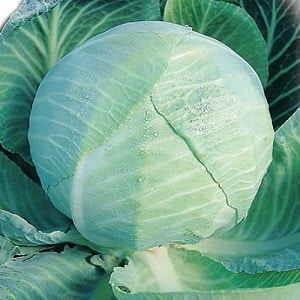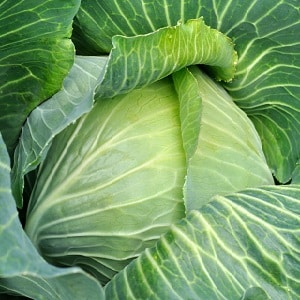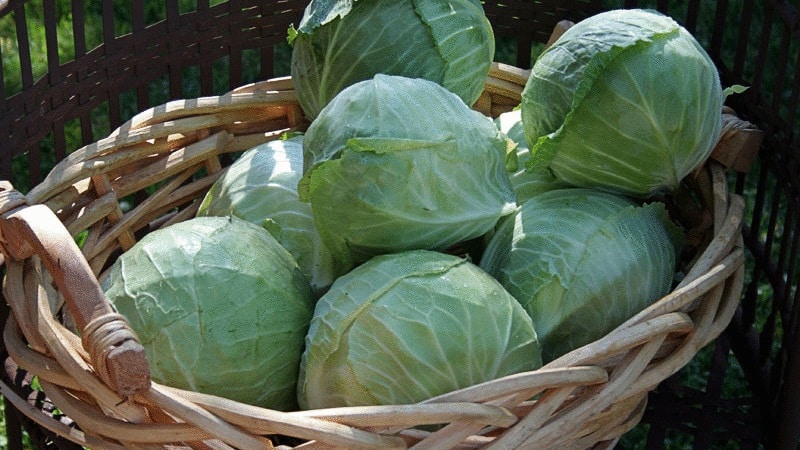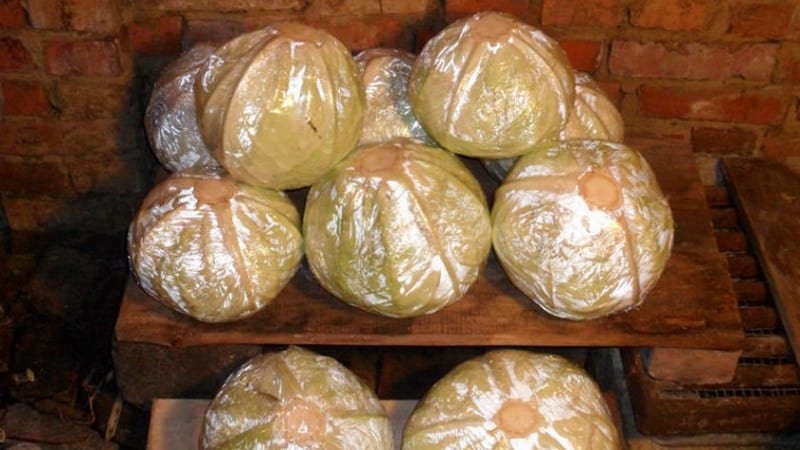Proven ways to keep cabbage fresh for the winter
In winter frosts it is nice to have fresh vegetables on the table. Imported and greenhouse products are available in stores all year round, but they are not distinguished by their excellent taste and great benefits. Therefore, many gardeners try to store their own harvest for as long as possible. This also applies to cabbage. We will tell you below how to keep cabbage fresh for the winter.
Is it possible to keep cabbage fresh until spring?
Taking out a head of fresh cabbage from the bins and quickly chopping it into a salad or using it for borscht is quite possible even in March. Under optimal conditions, vegetables of certain varieties can be stored almost in their original form for up to eight months..

Suitable varieties
White cabbage lasts longer than its exotic relatives – Brussels, broccoli, Beijing, Savoyard And color. However, the keeping quality varies among varieties.
Early ripening varieties are not suitable for winter storage, in some regions ripening by June. Loose heads of thin leaves do not tolerate storage well and quickly begin to rot, so this type of cabbage is served in the days immediately after harvest.
The champions in terms of shelf life are the late ones. varieties and hybrids. However, many of them are distinguished by tough leaves with hard veins, so they are not consumed fresh, but are used mainly for pickling and pickling.
They will last almost unchanged until next spring.:
 Amager 611 (pictured);
Amager 611 (pictured);- Aros F1;
- Snow White;
- Geneva F1;
- Wintering 1474;
- Crewmont;
- Turkiz;
- Kharkov winter;
- Miracle F1.
Late cabbage tends to improve taste while lying in storage due to the accumulation of sugars.
To pamper yourself with vitamin salads in winter, It is worth paying attention to mid-late varieties, especially hybrids:
 Atria;
Atria;- Countess F1;
- Dobrovolskaya;
- Winter Gribovskaya;
- Merchant's wife (photo on the right);
- Menza F1;
- Present;
- Symphony F1;
- Filibuster F1.
Selection of heads of cabbage for long-term storage
If you buy cabbage at the market or in a store and its variety is unknown, pay attention to the following signs:
- Late and mid-late varieties appear on the shelves at the end of September - October. Everything that is sold before is either early cabbage, or imported products, or remnants of last year’s harvest.
- The heads of late-ripening varieties are large and tight, the leaves are strong, tightly adjacent to each other. The upper ones may have a light green tint, but the lower ones are always white.
- The taste of late cabbage is bitter immediately after harvest, but softens after several months of storage.
If possible, choose heads of cabbage with the stalk not cut off at the very base. Such copies are stored longer.
When and how to properly harvest cabbage for long-term storage
Harvest time largely depends on the variety, so you need to carefully read the seed label. Late cabbage is harvested closer to October, when daytime temperatures drop to +2...+8°C and the first night frosts are observed.
There is no need to rush to cut the heads of cabbage, as cell sap should accumulate in the leaves. With its deficiency, cabbage begins to wither and crack.However, there is no need to delay collection, otherwise heavy rainfall and frosts below -3...-5°C will provoke putrefactive processes.

It is advisable to harvest the crop in dry, clear weather, and if it rains, dry the heads of cabbage under a canopy.. The stalks are left protruding 2-5 cm, and the covering leaves are left untouched. This will protect the cabbage overwintering in the cellar from pathogens and mechanical damage.
Reference. To store the heads of cabbage in a suspended state, the stumps are uprooted from the ground with a shovel.
Then forks are sorted, selecting only dense, ripened ones for storage. Immature, cracked, diseased or frozen specimens are discarded.
Some tricks will help increase the shelf life of the crop:
- to make the outer leaves more elastic and less brittle, they need to be allowed to wilt a little;
- Crushed chalk helps protect cabbage from rot - it is used to “pollinate” the cabbage heads before storing them;
- It is better not to put forks of different varieties in one place, especially those that differ greatly in the duration of the growing season.
It can be useful:
Where to store
There are many options for storing cabbage: basements, cellars, sheds, balconies, loggias and even earthen pits on a summer cottage. However, it is better to choose rooms with fresh ventilation, controlled temperature and humidity. It is also important to be able to periodically check the heads of cabbage and remove spoiled ones.

At home
If the size of your living space allows, you can hold the cabbage straight in the apartment. The ideal place would be a storage room in the hallway or even on the staircase - away from the central heating radiators.But do not count on a long shelf life for the heads of cabbage, since these storage facilities are still too warm and not humid enough.
At best, cabbage will last 1-2 months.
In the cellar (basement)
Optimal storage conditions for white cabbage are temperature 0...+2°C and humidity 80-90%. These conditions can be easily created in the cellar, so its presence gives every chance to preserve the harvest until spring.
The main factor for successful storage is cleanliness of the premises.. Therefore, the walls, floor and ceiling of the basement should be disinfected - treated with lime or a commercial antiseptic. This will protect surfaces from fungus and mold.
Attention! Eliminate the appearance of insects and rodents in the cellar. Block access routes: seal the cracks, cover the ventilation hole with a fine metal grill. You can use ultrasonic repellers, mechanical traps, but it is better to avoid using toxic substances.
Store cabbage in the form of a pyramidal stack on a dry wooden floor or spread out on racks. In both cases, it is necessary to ensure constant air circulation:
- the flooring is installed at a height of 12-15 cm from the floor;
- leave at least 20 cm between the racks;
- The recommended stack dimensions are no more than 1 m in width and 60-70 cm in height.
In a refrigerator
In the vegetable compartment or in the so-called “fresh zone” in the refrigerator, cabbage can be stored for up to 30-45 days.
To do this, it needs to be properly prepared.:
- wrap the heads of cabbage with paper or cling film;
- treat the forks and shelves of the refrigerator with anti-rot preparations;
- trim the stalk as much as possible.

From time to time, the wrapping film or paper is inspected for condensation.. If moisture appears, the cabbage is repacked.
Reference. Long-term storage of cabbage in the refrigerator is prevented by its close proximity to other products, light and constant opening of the chamber, which disrupts the temperature regime.
On the balcony
Storing cabbage on the balcony and loggia has some disadvantages:
- too dry and warm air on insulated loggias;
- the likelihood of frost is on non-insulated ones.
To create more favorable conditions, it will be necessary either constantly ventilate the room or insulate supplies.
Reference. A possible solution is to use a special heating cabinet or its budget alternatives - wooden boxes inserted into each other with a thermal insulation layer between them or a broken refrigerator. In such storage facilities it is easier to maintain a constant temperature of +2°C.
In earthen pits
Storing the cabbage harvest using this method is acceptable only if there are no other options.. Its main drawback is the high probability of freezing, dampness and rotting of the heads of cabbage. But it’s worth a try if there is a catastrophic lack of space in the apartment, but there is a summer cottage that is empty in winter.
To organize a pit:
- Dig a hole approximately 60x60x60 cm in size.
- The bottom of the pit is lined with straw, cabbage is laid on it in two layers, placing the heads of cabbage with the stalks facing up.
- The vegetables are again covered with straw and covered with a wooden shield.
- Cover the top with 20 cm of soil and level it with a rake.
Unfortunately, it will not be possible to check the condition of the vegetables without digging a hole and letting cold air in.
Optimal storage conditions
To ensure the freshness of cabbage for several months, the following conditions are needed::
- temperature not lower than –1°С and not higher than +5°С;
- high air humidity – 80-95%;
- restricting access to light;
- good air permeability (in the absence of constant ventilation, it is recommended to ventilate the room at least once a month);
- compliance with sanitary and hygienic standards - protecting supplies from mold, mildew, and small rodents.

Recommended temperature and humidity for storing cabbage are inversely related: the lower the temperature, the higher the humidity and vice versa. Therefore, in the main chamber of the refrigerator, where the heat is maintained at about 4°C, 80% humidity is sufficient.
Methods for storing fresh cabbage
Proper organization will help extend the shelf life of cabbage.: so that there is an air gap between the heads of cabbage and they do not press on each other with their own weight.
In film
Polyethylene a film wrapped around the head of cabbage in three layers retains the necessary level of moisture inside the head so that its leaves do not dry out and remain crispy. This method is often used when storing cabbage in the refrigerator or on the balcony.

Reference. Vegetables are packaged in film for hygienic purposes - it protects from external influences, harmful microorganisms and insects. To be sure to get rid of insect pests, it is recommended to first soak the cabbage in salted water, dry it or blot it with a cotton towel, and only then pack it.
In paper
Paper creates additional thermal insulation, and the forks completely wrapped in it do not touch each other. Cabbage packaged in this way can be stored in boxes and bags.
Reference. It is better to use thin parchment paper for wrapping. Colored and newspaper materials contain lead.
In the box
Due to the gaps between the slats, the box is ventilated, so it is well suited for storing vegetables. The material of manufacture and the dimensions of the container are not particularly important.
Place the boxes in stacks that are not too close to each other. To ensure air access, leave 10 cm between them on each side.

On the grid
Large mesh gives a good visual overview of the cabbage stored in it – this makes it easier to inspect the supplies for damage without taking each head of cabbage out of the bag. Another plus is ease of transportation, since the packaging weighs almost nothing.
It is better to place bags and nets on wooden pallets or racks, rather than on a cold earthen floor.
In sand
Sand between cabbage forks serves as a natural adsorbent and heat insulator., therefore maintaining supplies for as long as possible.
Several options for storing cabbage in sand are described. The first allows you to arrange stocks more compactly:
- A generous layer of well-dried clean sand is poured onto the bottom of the wooden box.
- The heads of cabbage are laid on top with the stalks facing up.
- Sand is again poured over the cabbage and the layers are repeated until the box is full.
The second option can lead to rooting and germination of the vegetable:
- The bottom of the box is filled 20 cm with sand.
- The forks are laid in one layer, sticking the stalks into the sand.
To prevent the appearance of pathogenic microflora, it is better to pre-calcinate the sand.. This will also get rid of excess moisture.
In clay
To preserve freshness and a pleasant crunch, cabbage can be wrapped in a “clay coat”. To do this, clay is mixed with water in a 2:1 ratio to obtain the consistency of thick sour cream. Then coat each head of cabbage and place it at a distance from each other so that the layer is completely dry. When the clay hardens, the cabbage is placed on a shelf or in boxes.
Aweigh
To hang cabbage from the ceiling, keep the stumps as long as possible. One end of a strong non-slip thread (twine, twine) is tied around the stump, the other is secured to any holders under the ceiling: beams, hooks, stretched ropes, etc.
Heads of cabbage suspended in this way do not cake, as they are well ventilated. They are always in sight and can be examined from all sides. As a result, cabbage remains fresh until summer.
Best before date
The shelf life of cabbage depends on many factors.:
- Keeping quality of varieties. Varieties with excellent keeping quality are edible for seven months, with good keeping quality for six months, and with satisfactory keeping quality for four months.
- Temperature conditions. At room temperature (+20...+22°C) the vegetable can be stored for up to three months, at a temperature of 0...+2°C - up to seven months.
- Availability of packaging. Heads of cabbage wrapped in film or paper, sprinkled with sand or coated with clay are more protected from the external environment.
- Ventilation of premises. Lack of air and its mustiness shorten the shelf life of any product, including cabbage.
- Sanitary conditions and diseases. Microorganisms and rodents contribute to the development of diseases (mold, mucous and vascular bacteriosis, gray and white rot, phomosis, punctate necrosis).
Conclusion
How to properly store cabbage so that it stays fresh until spring? It's possible, but difficult. It is necessary to organize the right conditions, which are not always available to city dwellers: a cool and damp room without access to sunlight, but with good ventilation.
Supplies stored in the refrigerator or on the balcony have a short shelf life, so in the absence of a cellar, the best solution would be to ferment the cabbage.